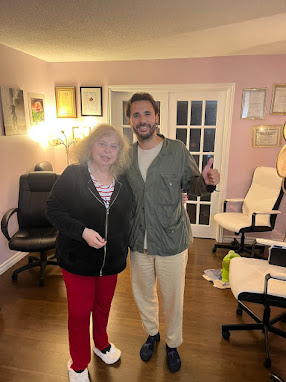Vocalscience ™ Method - The Alternative Approach to Speaking and Singing.
I can also, with absolute
certainty, say that you are what you speak and sing.
With the holistic approach in mind, I should mention that the
voice (in my definition) is an expression of who you are and identification of the state of your
being. The voice is a very important tool for
communication. When you speak with the
person, by his/her voice tone, you can determine the person’s mood and even the
state of the person’s health; especially if you are at least somewhat
familiar with that person.
On that note, I could say
that when I work with the Voice Repair client and get their voice 'out of their
throat' by restructuring it to the facial and abdominal muscles, the person
starts sounding completely different, i.e., the voice starts to sound much
healthier, more vibrant, more colorful and more reflective of the actual
person’s make-up.
The sound becomes much
clearer and the words are more announced and pronounced. The hoarseness disappears and
the tone of the voice changes. When we are talking about the
voice disorder, the voice often sounds quite "soprano'ish". It is especially pronounced
with the male gender where the condition, described above, causes a lot of discomfort and
insecurities.
These peoples’ lives become
(in a manner of speaking) "handicapped", as they are afraid to communicate in person and
terrified by phone conversations while simply not ever picking up the phone, let alone, initiating any phone conversations of their own. Nevertheless, it does affect both their social lives
and their professional lives.
Needless to say, most of them
are depressed and some of them are even suicidal.
Once the voice is improving
and they are gradually reclaiming their lives, they are also gaining back
their zest for life. Their mood becomes
exponentially happier, their spirit is rejuvenated and their 'soul is now
singing', even though that some of them have never sung in their lives.
Those, however, who are
singers (or I should say, ‘have had been singers before they damaged their
voices’), have been experiencing the "double whammy". They need to restore their
speaking voice first, and then, and only then, their singing voice. However, the good news is
that after the speaking voice falls into place, it is much easier to fix the
singing voice - as ultimately, the voice mechanics for both - the speaking and singing voice - are very similar in their nature.
With the singers, however, I
have to restore their tone and mainly pitch which, in some cases, becomes
very challenging. Usually, in these cases, the
confidence is really damaged, as the singer is scared to reach the high notes
as he/she is naturally trying to protect his/her voice. Therefore, on the background, there is a lot
of psychological counseling that is required for those cases.
“I have to say, it has been
the making of me meeting you Diana in more than just the voice,” - wrote to me, one
of my former Voice Repair clients; presently a United Kingdom Opera Singer.



